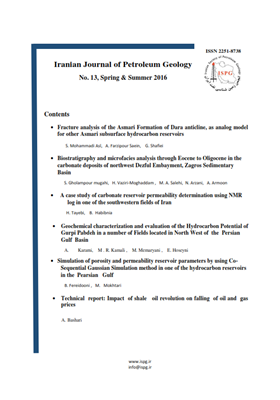-
-
List of Articles
-
Open Access Article
1 - Fracture analysis of the Asmari Formation of Dara anticline, as analog model for other Asmari subsurface hydrocarbon reservoirs
saeed mohammadi asl Ali Farzipour Saein Ghodratollah Shafiei -
Open Access Article
2 - Geochemical characterization and evaluation of the hydrocarbon potential of Gurpi in a number of fields Located in North West of Persian Gulf
MohhamadReza Kamali محمود معماریانی Ehsan Hosseni Arezoo Karami -
Open Access Article
3 - Simulation of porosity and permeability reservoir parameters by using Co-Sequential Gaussian Simulation method in one of the oil field in the South West of Iran
Bahareh Fereidooni Mohammad Mokhtari -
Open Access Article
4 - A case study of carbonate reservoir permeability determination using NMR log in one of the southwestern fields of Iran
Bahram Habibnia -
Open Access Article
5 - Biostratigraphy and microfacies analysis of the Shahbazan and Asmari formations (through Eocene to Oligocene) in the carbonate deposits of northwest Dezful Embayment, Zagros Sedimentary Basin
sepedeh Gholampoor-moghahi Hosyen Vaziri moghadam Naser Arzani Afshin Armoon -
Open Access Article
6 - Impact of shale oil revolution on falling of Oil and Gas prices Technical report
Ali reza Bashari
-
The rights to this website are owned by the Raimag Press Management System.
Copyright © 2017-2025







